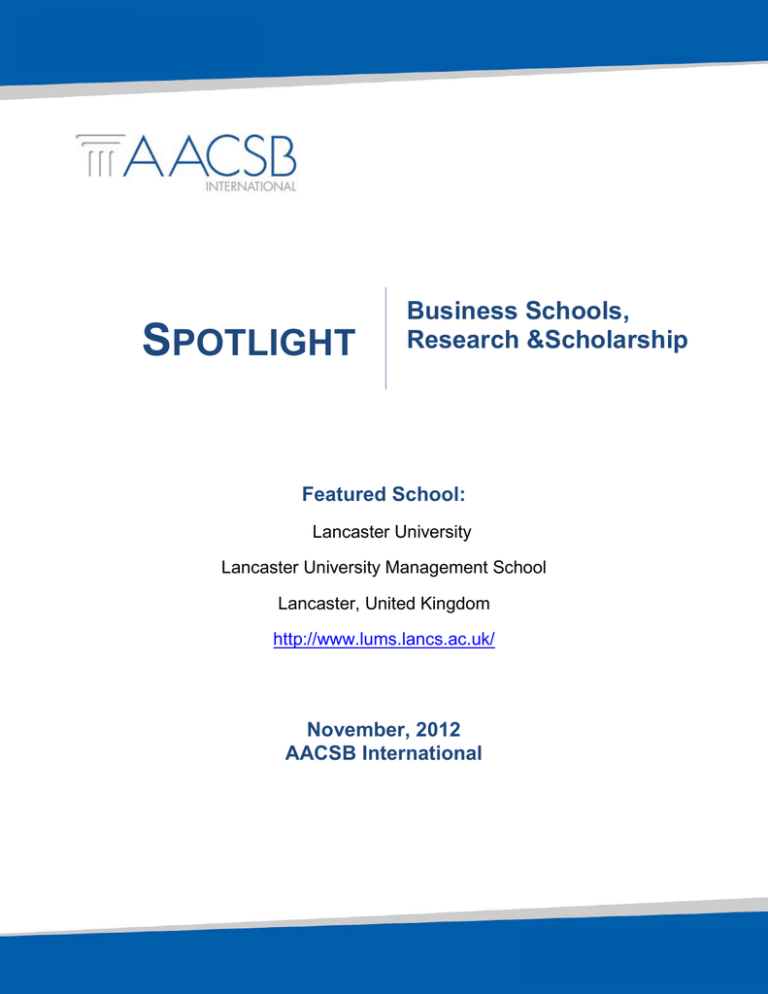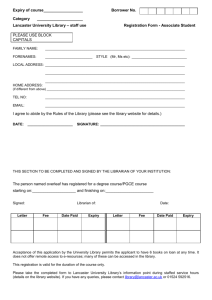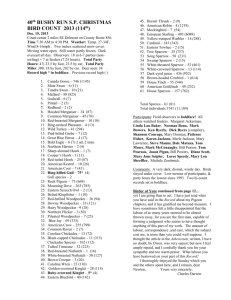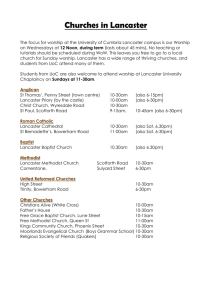
SPOTLIGHT
Business Schools,
Research &Scholarship
Featured School:
Lancaster University
Lancaster University Management School
Lancaster, United Kingdom
http://www.lums.lancs.ac.uk/
November, 2012
AACSB International
SPOTLIGHT| Business Schools & Research/Scholarship
Lancaster University Management School 2
Centre for Performance-led Human Resources (CPHR)
Lancaster University Management School's Centre for Performance-led Human Resources (CPHR) was
established to provide a European based hub for HR research. In the six years since its founding, CPHR
has been successful in its goal by providing thought leadership in the area of HR through its publications,
collaborations, and general research efforts. It has attracted over £1.6 million of industrial funding.
The Centre's longtime director Professor Paul Sparrow comments that CPHR was created when a
number of HR directors based in the United Kingdom surveyed the landscape and felt that there was a
distinct lack of European presence in the field of HR research, with the majority of publications being
produced from the United States. The call was then raised to develop a center in the United Kingdom
focusing on these issues, and Lancaster University became involved in the discussion early on as a
potential hosting institution. From the beginning, the imperative was set that the issues that would be
examined needed to be relevant, embedded in practice, and looked at within a research context. After
laying out the core concepts behind the Centre and obtaining the necessary funding, Professor Sparrow
was brought in to direct CPHR's operations. The first year was spent in negotiations with local HR
directors regarding what really was meant by "performance-led HR," and defining the academic
boundaries and goals for the center's studies.
CPHR was situated in the business school with specific considerations in mind. Structurally, the Centre
could have been situated in any of the teaching departments, as Lancaster University does not have a
specific HR department. However, the initial dialogue made it clear that the Centre should be separated
from any specific academic area. As HR is highly multifaceted, CPHR needed to be in a position to reach
across the disciplines. The business school has kept CPHR independent and thus able to maintain its
cross-disciplinary focus. With the Centre's capacity to look across disciplines, and their focus on working
across a variety of different kinds of institutions, their research is capable of yielding well-rounded data.
This independence was the primary reason that the business school was chosen to host CPHR.
CPHR works directly with a variety of local and international companies in its research efforts. These
companies are often both sponsors and members of CPHR. Professionals from these companies share
insights and provide a real world look into what is going on in business HR. Alongside these
professionals, the Centre identifies two to three topics each year, typically related to HR policy, upon
which they produce a "white paper," or insight into the practice. These papers may be co-written with
practitioners. CPHR then tests these concepts with the practitioners. As an example of this, the Centre
runs several special interest groups covering topics such as engagement, organization design, health and
wellbeing, HR strategy, and talent. For the talent group, CPHR brings together a multitude of "talent
directors" for a sit-down meeting. In these meetings, there is a confidential discussion of what these
directors are working on in terms of practice. Each conversation is recorded for internal use. These
conversations are useful for the Centre as they shape and frame the questions that the research team
needs to look at. Professor Sparrow considers it a "sharpening process," for testing and validating
concepts, leading to a refinement of data and overall understanding.
Funding CPHR
The primary funding for the Centre comes through a subscription based model. The sponsors of CPHR
are typically HR directors, who are also members. Professor Sparrow points out that the intent was to
create a small "club" with an honest and detailed exchange. Initially, the Centre required a five-year
agreement of sponsorship, but this has since been amended to a three-year agreement. This subscription
model underpins the majority of the activities of the Centre. These financial resources are used to
produce white papers and resources for the special interest groups. In addition to the subscriptions,
CPHR also engages in consultative work to generate funding. The Centre is often given access to a firm's
data for the purpose of analysis. CPHR is able to analyze this data and recommend practical solutions,
for a nominal fee.
© AACSB International. All Rights Reserved.
SPOTLIGHT| Business Schools & Research/Scholarship
Lancaster University Management School 3
Research Phases and Themes
The Centre divides its research into capsules, with their initial phase of research spanning from 2007 to
2010. The primary function of their research during this time, dubbed "phase 1," had been on finding ways
to increase the productivity of the workforce in the United Kingdom. To this end, CPHR undertook a host
of projects focusing on performance as it relates to overall productivity. Using data acquired through firsthand research and the information provided by the collaborating firms, the Centre produced a white paper
series, as well as a research book entitled, Leading HR. This series was co-authored by the HR directors
of collaborating firms to ensure it offered results centered on real world application, more so than pure
theory. This first phase was underpinned by a view that had been taken within the field of HR
management, which enabled the Centre to be distinctive, and to stand out from the other centers. The
primary areas investigated included strategic competence, boardroom engagement, business model
1
change, evaluating how people improve organizational capital, and overall HR trajectories.
Following their initial research phase, CPHR shifted focus for phase 2, spanning from 2010 to 2011. The
attention turned to questions of long-term and sustainable performance. The Centre is now entering
phase 3, building upon what they have researched over the past several years. The themes identified in
the initial two phases are still being investigated, but there are emerging areas of interest to CPHR's
studies. Of these, innovation, customer centricity, lean management, and global integration are the
2
primary themes being studied.
In reference to future goals, Professor Sparrow comments that, "We've always said that the work we do
needs to be cross-disciplinary, as there is a need for this in academic study. What's happening is that
organizations are dealing with problems that span across the disciplines, and most HR research has not
reflected this."
Additional Offerings
Lancaster University Management School (LUMS) has leveraged the research done through CPHR,
offering contributions to master’s courses based upon some of the Centre's findings. With CPHR's special
interest groups, there was highly specific research done in key areas related to HR, allowing the Centre to
produce masters classes which are extremely practice-based in form (with all the insights and examples
already having been acquired through the Centre's studies). CPHR offers masters classes in
organizational design, HR strategy, leadership, employee engagement, and talent management.
When these courses were initially designed, they weren't intended to be utilized by the sponsoring
businesses. The aim was to capsulate the insight from the Centre's members for distribution to outside
learners. However, a number of the existing and incoming sponsor firms found the classes useful for their
teams. Two very large organizations put their entire organizational development teams into these classes.
These organizations wanted to utilize CPHR's independence and thought provocation as a way of
addressing the issues they face within their own businesses. At this time, there are no plans for
expanding these offerings into executive education, although the
capacity is there with a sufficient breadth of material, according
to Professor Sparrow.
Addressing the cross-disciplinary focus that CPHR was designed
for, along with Professor Cary Cooper, Professor Sparrow has
founded a journal entitled, Journal of Organizational
Effectiveness: People and Performance. It has an advisory
board made up of a variety of academics representing a wide
3
range of HR research centers and schools. The need for this
journal was established based upon the findings from the initial
two research phases of CPHR. While Professor Sparrow notes
that there is always competition amongst other centers, he says
there is an increasing understanding that there are many
© AACSB International. All Rights Reserved.
"The field is maturing, and
getting to a stage where
people can see a
common purpose." Professor Paul Sparrow
SPOTLIGHT| Business Schools & Research/Scholarship
Lancaster University Management School 4
common interests, fueling the creation of the journal. Tying together the findings from the many different
HR centers can enable a more rapid ability to influence practice coming from common academics. When
the journal was initially discussed, Professor Sparrow received offers of involvement from several major
HR centers in the U.S., Europe, and Australia. According to Professor Sparrow, "The field is maturing,
and getting to a stage where people can see a common purpose."
Both Timely and Relevant
The timeliness of the research being done is very important to CPHR. There is a need to get the research
into the hands of the practitioners for implementation with relative haste, due to the nature of the rapidly
changing environment. "In the world we're living in now, organizations need there to be academically
sound research, and for it to be significant, relevant, and time sensitive," comments Professor Sparrow.
He continues, "It needs to be timely enough that they can choose to act upon it, which can be challenging
with the lengthy validation process, along with academic approval and publication."
CPHR's focus on timely research is driven by a push to provide solutions while they are still applicable.
As a demonstration of this, there was one retail organization that the Centre worked with which was
studying the impact of employee attitudes on business performance. In working with them, CPHR found
early on that employee attitude had a significant impact on the performance of their stores. The Chief
Operating Officer, recognizing this, decided to send the organization's HR department to work with CPHR
each year, focusing on HR strategy for improving attitude, and thus, performance. The Centre became a
sounding board for them on areas of concern. Through this relationship, CPHR found that the age
demographic of their stores also had a surprisingly significant impact on store performance. The
organization began to shift resources and change their structural makeup in light of these findings. All of
these discoveries and adjustments happened prior to any official publication.
In the United Kingdom, there is a new Research Excellence Framework (REF). REF will be replacing the
current Research Assessment Exercise (RAE) in 2014. With REF, 20 percent of the evaluation will be
4
based upon the impact on research. This impact is not limited to academic citations reflected in journals,
but rather the user impact of research. Within a changing world, this impact has become a critical
consideration and is one of the driving factors at the Centre. CPHR is results-driven, seeking to support
businesses with timely data. One of the debates in the United Kingdom relates to this discussion of
academic impact. On this, Professor Sparrow notes that, "when you have a centre operating [as CPHR
does], you are able to think about impact in more useful and less traditional ways. You think about the
papers being produced, and how people will adopt these ideas."
Professor Sparrow explains the center's focus on impactful research:
We're in a world where there is more capability inside of organizations to develop their
own research, with them able to access journals and other sources. They can produce
knowledge as quickly as we can. If your research is going to have an impact, it needs to
influence practice or policy before it gets published, or at least in parallel . . . There will be
debate for the next five years about what we mean by impact. To me, that creates a
positive opportunity for us as academics, to be able to demonstrate that we can not only
5
do rigorous research, but that we can be extremely relevant.
Acknowledgements: AACSB International is grateful for the assistance of Professor Paul Sparrow,
Director of the Centre for Performance-Led HR at Lancaster University Management School.
© AACSB International. All Rights Reserved.
SPOTLIGHT| Business Schools & Research/Scholarship
Lancaster University Management School 5
End Notes
1
Centre for Performance-Led HR. (n.d.). Retrieved 10/29/2012, from Lancaster University Management School:
http://www.lums.lancs.ac.uk/research/centres/hr/remit/
2
Centre for Performance-Led HR. (n.d.). Retrieved 10/29/2012, from Lancaster University Management School:
http://www.lums.lancs.ac.uk/research/centres/hr/pkase3/
3
Centre for Performance-Led HR. (n.d.). Retrieved 10/29/2012, from Lancaster University Management School:
http://www.lums.lancs.ac.uk/research/centres/hr/JOE/
4
REF2014. (n.d.). Retrieved 10/29/2012, from Research Excellence Framework: http://www.ref.ac.uk/
5
Sparrow, Paul. (2012) Personal communication, 10/15/2012.
© AACSB International. All Rights Reserved.







